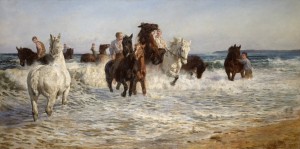the horse: ngv exhibition review

Lucy Kemp-Welch, Horses bathing in the sea, 1900, oil on canvas, 152.9 x 306.5 cm, National Gallery of Victoria, Melbourne, Purchased, 1900 © Estate of Lucy Kemp-Welch
Did you know that horse worship and cultism was a common facet of nomadic Eurasian cultures? Or that in Indian mythology, the seven-headed horse Uchchaihshravas – translating roughly to either ‘long-ears’ or ‘neighing aloud’- was regarded a king of horses, and was the mount of the Hindu god Indra, the god of rain and thunderstorms? And that in ancient Greek mythology, the snow-white Pegasus, a winged horse, was placed as a constellation in the sky, to herald the coming of springtime? For centuries, this majestic creature, both in and out of mythology, has played an integral role in shaping cultures and ideologies.
In Australian colonial settlement, horses played an integral role, both in fuelling conflict between European settlers and indigenous tribes, and also in the creation of a new colonial settlement. In 19th century bushranging culture, horses were symbols of both authority and rebellion. In the quintessential folk tale, Waltzing Matilda, a squatter is described as being ‘mounted on his thorough-bred’. And did you know that notorious Victorian bushranger Ned Kelly was imprisoned for three years after being caught in possession of a stolen horse?
Represented extensively in popular culture, celebrated in ancient and contemporary mythology, explored in classic literature, and finally, found represented diversely in many forms and periods of visual art. Spanning regions and religions, the horses’ significance prevails. In the art world and out of it, horses have been highly respected – and exploited – for their role in shaping human civilisation, industry and culture.
The Horse, an exhibition now on display at the National Gallery of Victoria, takes the viewer through three thousand years of this majestic animal’s rich and diverse history. It encompasses two gallery spaces, and is divided into overarching themes including Mythology, Divinity, Chivalry, Pageant, Labour, Conflict, Tragedy and Pleasure.
As well as paintings and sketches, the exhibition includes elaborately-illustrated ceramic pieces and tapestries, and more contemporarily, archetypical examples of riding garments and equipment. It also features relics of the renowned Melbourne Cup; of fashion and festivity, and footage of champions including the immortalised Pharlap in one of his most celebrated hours.
Notably, the exhibition also explores the relationship between horses and women. A symbol of power and status, the ability to own or ride a horse allowed women the potential of elevated social standing, and allowed them to challenge stereotypes and expectations imposed on them.
For example, during China’s Tang dynasty (618AD – 907AD), the importation of breeding stock from the Middle East led to a refinement of equine cultures among the ruling classes. Equestrian pageants and games were enjoyed by all in a period when women were allowed greater social freedoms than ever before. Reflecting the belief that life continues after death, Tang dynasty tomb sculptures provide a fascinating record in ceramic of the elegance and ritual of court life in China at the time.
Another interesting featured work is Napier Waller’s ‘The Amazons’ (c. 1924), depicting Amazonian tribeswomen gathered together, grooming their horses. Since the nineteenth century, historians have debated whether these women comprised an actual matriarchal community or instead, were merely mythical ‘others’ whose legend grew from ancient societies’ fear of alien cultures. Intriguingly, in the remote Ural region of Russia in the 1990s, archaeologists uncovered millennia-old graves of equestrian warrior women buried with weapons signifying their principal pursuit in life – daggers, quivers and arrows.
If you’re interested in learning more about the horse, and its significance within the art world and out of it, the exhibition is well worth a visit. The Horse is free entry and runs until November 8 2015.

